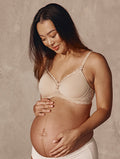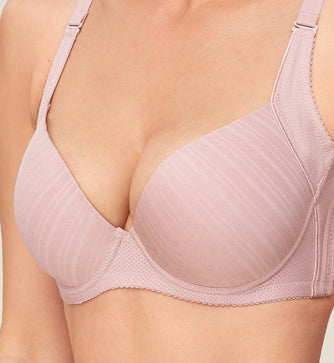Bra Fitting Guide
At Triumph, we believe that a perfectly fitting bra is the foundation of feeling comfortable, confident, and empowered every day. A well-fitted bra is more than just lingerie—it’s essential for your posture, breast health, and overall wellbeing.
Why Bra Fit matters
The right bra fit means all-day comfort, support, and confidence. It moves with you—no digging, slipping, or pinching—while enhancing posture and shaping your silhouette.
Visit us in-store for a fitting with one of our bra-fitting experts and find your perfect fit.
How To Measure
Accurate measurements ensure your Triumph bra fits perfectly for comfort and support. If you’re between sizes or trying new styles, sister sizing helps you find alternative band and cup combinations for the best fit.
The Swoop & Scoop Method
While measurements are essential, nothing replaces trying on your bra—using the ‘Swoop and Scoop’ method.
The Swoop & Scoop method helps ensure your bra fits properly by guiding all breast tissue into the cups. By leaning forward, fastening the band, and gently adjusting each breast, you achieve better comfort, support, and a more accurate fit. It's a key step in making sure your bra fits as it should.
What A ‘Perfect Fit’ Looks Like
5 key signs your bra fits right
1. It Feels Comfortable All Day.
2. It Stays in Place Without Constant Adjusting.
3. It Supports Your Daily Activities with Ease.
4. It Boosts Your Confidence and Enhances Your Look.
5. It Promotes Good Posture and Reduces Back Pain.
Bad fit warning signs
Skin chafing or irritation - Redness, blisters, or itching usually mean your bra is too tight.
Underwire discomfort – If the underwire digs into your breast tissue or arm, your cup size is off.
Band riding up – A band that rides up your back is too loose; if it rides up in front, the style isn’t right for you.
Breasts falling out underneath – A loose band or too-small cups can cause breasts to slip out.
Cup spillage – Bulging at the top or sides shows your cups are too small.
Cup gaping or wrinkles – Extra fabric or gaps mean your cups are too large.
Here's what to look for with different bra types
9 Common Fitting challenges
Band Issues
Challenge: Band rides up, feels too tight, or digs in.
Solution: If it rides up, the band is too loose — go down a band, up a cup; if it’s too tight or digs, go up a band, down a cup. The band should sit snug and level and provide most of the support.
Cup Fit
Challenge: Cups gape or wrinkle, or there’s spillage/“quad-boob.”
Solution: Gaping/wrinkling = cup too big; spillage = cup too small. Try the next cup size, a different cup shape, or use the scoop & swoop to position tissue so the cup hugs smoothly.
Straps
Challenge: Straps dig in, slip, or fall off.
Solution: If straps dig, the band may be too loose — the band should carry the support; if straps slip, shorten them slightly, move to a closer-set or racerback style, or adjust placement so straps sit comfortably without bearing most of the load.
Underwire
Challenge: Underwire pokes, digs, or sits on breast tissue.
Solution: Usually the cup is too small or the band too big — try up a cup or down a band, or a different wire shape. A correct wire lies flat against the chest and fully encases the breast.
Gore (Center Front)
Challenge: Gore doesn’t lie flat or it digs in.
Solution: If it lifts away, cups may be too small or the band too loose; if it digs, cups may be too big or the style may not suit your shape. The gore should rest flat and feel comfortable.
Asymmetry
Challenge: One breast is larger than the other.
Solution: Fit to the larger side and use removable pads or inserts on the smaller side; stretch-lace or molded cups can visually balance the shape.
Orange in a Glass
Challenge: Cup looks empty or wrinkles like an orange in a glass.
Solution: Cup shape/size mismatch — try a smaller cup, a more projected style, or a different cup shape that fills the cup smoothly.
Tail of Spence
Challenge: Breast tissue extends toward the underarm.
Solution: Totally normal — scoop that tissue into the cup and try full-coverage or side-support styles that contain and support it.
Body Changes
Challenge: Pregnancy, breastfeeding, menopause, or weight changes affect fit.
Solution: Re-measure and update sizes as needed; choose adaptable styles (stretch lace, non-wired, multi-hook) that adjust with your body.















